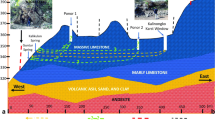Abstract
The Torbali River Basin is an important part of the Kucuk Menderes Basin in western Turkey, containing a highly productive alluvium aquifer. Hazardous waste from urbanization and industrialization has been stored above the main unconfined alluvial aquifer for the last five years. This study is intended to determine the surficial aquifer vulnerability characteristics and to assess the groundwater pollution mechanism from the hazardous landfill site that is located above the surficial aquifer. Two main vulnerable zones of the aquifer were determined using a GOD vulnerability model. The hazardous solid waste was dumped on a moderately vulnerable zone without any precautionary measure. Leachate seepage from the landfill is a main contaminant for NaCl water types with electrical conductivity (EC) values of 4,275 to 4,575 μS/cm. The pH values of the leachate are between 6.3 and 6.6. Concentration of As, Al, Fe, Mn, Ni, Sb, Se and Cd in the leachate are above and Pb, Zn and Cu concentrations are below the drinking water standards. As a result, the waste leachate has a high contaminant content that is causing groundwater pollution in a highly productive vulnerable zone. In this case, this vulnerable zone is not suitable for waste disposal activities, and some improvement studies should be done immediately to protect the main aquifer from the hazardous landfill site.
Similar content being viewed by others
References
Aller, L., Bennett, T., Lehr, J.H., Petty, R.J. and Hackett G., 1987, DRASTIC: A standardized system for evaluating groundwater pollution potential using hydrogeological settings. Prepared for the U.S. Environmental Protection Agency, Office of Research and Development, EPA-600/2-87-035. National Water Well Association, Dublin, Ohio.
Apleyard, S.J., 1996, Impact of liguid waste disposal on potable groundwater resources near Perth. Environmental Geology, 28, 106–110.
Ayers, R.S. and Westcot, D.W., 1985, Water Quality for Agriculture. FAO Irrigation and Drainage Paper No. 29, Rev. 1, U. N. Food and Agriculture Organization, Rome.
Bagch, A., 1994, Design, Contruction and Monitoring of landfill, John Wiley & Sons, 2.nd edn, pp 99–107, Canada.
Celik, M., 2002, Water quality assesstment and the investigation of the relationship between the River Delice and the aquifer systems in the vicinity of Yerköy (Yozgat), Environmental Geology, 42, 690–700.
Civita, M., 1994, Vulnerability maps of aquifers subjected to pollution: theory and practice, Pitagora Editrice, Bologna (in Italian).
Edet, A.E., 2004. Vulnerability evaluation of a coastal plain sand aquifer with a case example from Calabar, southeastern Nigeria. Environmental Geology, 45, 1062–1070.
EU, 1998, Directive 200/60/CE relative to human drinking water quality. Official Journal of European Union Communities L327.
ESRI, 1999, Getting to know ArcView GIS, 3rd edition, ESRI Press, California.
EPA, 1999, Landfill Manual: Landfill Site Design. Environmental Protection Agency.
Fatta, D., Papadopoulos, A. and Loizidou, M., 1999, A study on the landfill leachate and its impact on the groundwater quality of the greater area. Environmental Geochemistry and Health, 21, 175–190.
Foster, S.S.D., 1988, Groundwater recharge and pollution vulnerability of British aquifers: a critical overview. Geological Society Special Publication, No 130, London.
Fredrick, K.C., Becker, M.W., Flewelling, D.M., Silavisesrith, W and Hart, E.R., 2004, Enhancement of aquifer vulnerability indexing using the analytic-element method. Environmental Geology, 45, 1054–1061.
Garcia, G.M., Hidago, M.D. and Blesa, A.M., 2001, Geochemistry of Groundwater in the Alluvial of Tucuman Province. Hidrogeology Journal, 9, 597–610.
Ibe, K.M., Nwankwor, G.I. and Onyekuru, S.O., 2001, Assessment of groundwater vulnerability and its application to the development of protection strategy for water supply aquifer in Owerri, Southeastern Nigeria. Environmental Monitoring and Assessment, 67, 323–360.
Paschke, N.W. and Hopples, J.A., 1984, Bouyand contaminant plumes in groundwater. Water Resource, 20(2), 1183–1192.
Sadek, M.A. and AbdEl-Samie, S.G., 2001, Pollution vulnerability of the quaternary aquifer near cairo, Egypt, As indicated by isotops and hydrochemistry. Hydrogeology Journal, 9, 273–281.
Simsek, C., 2007, The GIS-integrated surficial aquifer potential mapping and its importance for aquifer protection, Kucuk Menderes Basin/West Turkey. State Hydraulic Works, International Congress on River Basin Management, 22–24 March 2007, Antalya, Turkey, 78–94.
Simsek, C., Kincal, C. and Gunduz, O., 2006, A solid waste disposal site selection procedure based on groundwater vulnerability mapping. Environmental Geology, 49, 620–633.
Simsek, C., Karaca, Z., Gemici, U. and Gunduz, O., 2005, The assessment of the impacts of a marble waste site on water and sediment quality in a river system. Fresenius Environmental Bulletin, 14, 1013–1023.
Simsek, C. and Filiz, S., 2005, The hydrogeology and vulnerability of aquifers in Torbali plain and vicinity, Journal of Science and Engineering in Dokuz Eylul University, 7, 21–37 (in Turkish).
Simsek, C., 2002, The hydrogeological investigations for the site selection of the landfill area of the Torbali Plain. Ph.D. thesis, The Graduate School of Natural and Applied Sciences, Dokuz Eylul University, Izmir, 197 p (in Turkish).
Simsek, C., 1998, The hydrogeology of Torbali Plain, MS.c. thesis, The Graduate School of Natural and Applied Sciences, Dokuz Eylul University, Izmir.
Ulrich, G.A., Breit, G.N, Cozzarelli, I.M. and Suflita, J.M., 2003, Sources of sulfate supporting anaerobic metabolism in a contaminated aquifer. Environ Science and Technology, 37, 1093–1099.
Unal, N., Nurlu, S., Komurcu, A., Gundogdu, A. and Demir, R., 2001, Solid waste application of the Izmir and around country. Environmental and Geology Symposium Cevjeo-2001 pp: 417–426 (in Turkish).
Torbali Municipality, 2002, Environmental Impact Assessment Report of the Saibler Landfill Site, Torbali, Izmir (in Turkish).
TSE-266, 1997, Turkish drinking water standards. Turkish Standards Institute, Ankara
WHO (World Health Organization), 2002, Water and Sanitation. Guidelines for Drinking Water Quality, http//: www.who.int/water_sanitation_health/GDWQ, 2002.
Author information
Authors and Affiliations
Corresponding author
Rights and permissions
About this article
Cite this article
Şimşek, C., Gemici, U. & Filiz, S. An assessment of surficial aquifer vulnerability and groundwater pollution from a hazardous landfill site, Torbali/Turkey. Geosci J 12, 69–82 (2008). https://doi.org/10.1007/s12303-008-0009-6
Received:
Accepted:
Published:
Issue Date:
DOI: https://doi.org/10.1007/s12303-008-0009-6




